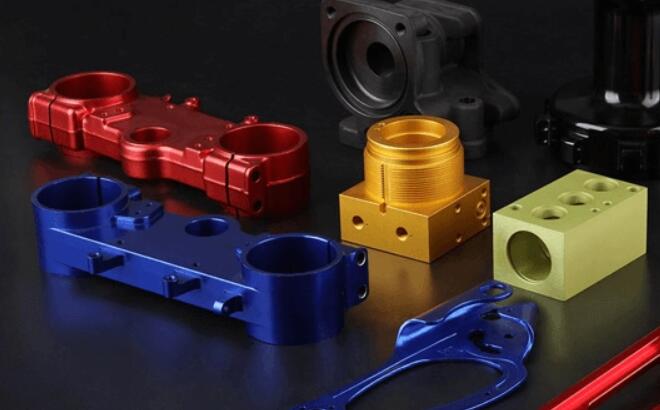Hard anodizing is the process of functionally refining aluminum components by using the anode in a specific cold electrolyte. The process of hard aluminum anodizing results in the formation of conversion coatings that are extremely thin and non-metallic. In this article, we’ll take a look at an overview of the hard anodizing of aluminum, including the properties of the hard anodized coating, the characteristics of different aluminum alloys, and some differences between hard anodizing and regular anodizing.

Difference Between Regular Anodizing and Hard Anodizing
The main difference between the hard anodizing process and the ordinary anodizing process are as follows:
1) The tank temperature of hard anodizing is very low, and it is recommended to be about 0 ℃, which requires a powerful refrigerator and mixing circulation device. The lower the temperature, the harder the oxide film quality.
2) The sulfuric acid concentration of hard anodizing is relatively low, and it is recommended to be about 130g/L, and the aluminum ion content should be controlled within the range of 5~10g/L.
3) The current density and voltage of hard anodizing are higher. It is recommended that the voltage should be above 30V and the current density should be above 2.5A/dm2. The specific electrical parameters should be determined in combination with the tank temperature, sulfuric acid concentration, alloy material, etc.
4) Pulse power supply or special waveform power supply should be adopted, and the voltage shall be increased gradually in the boost phase, so as to avoid the burning of materials under excessive voltage on the one hand, and promote the growth of oxide film in a normal way on the other hand.
5) Hard anodizing can also add some organic acids to the tank solution. The organic acid can improve the hardness and toughness of the oxide film. The organic acid solution can also be directly used in the anodizing process on some special occasions.
Characteristics of Hard Anodizing of Different Aluminum Alloy Series
1) 1xxx Series aluminum alloy, which is the easiest to be hard anodized and obtain the oxide film with high insulation and hardness.
2) It is difficult to hard oxidize the 2xxx series aluminum-copper alloy. Mainly copper rich intermetallic compounds are preferentially dissolved in the anodizing process, resulting in discontinuous oxide coating or pinhole defects. The solution is usually to adopt AC/DC superposition or pulse power supply, change the electrolyte composition and electrical parameters, etc. to avoid hard oxygen defects of the 2xxx alloy.
3) The technology of hard anodizing of 5xxx series aluminum magnesium alloy is generally difficult. The hardness of the coating is slightly lower than that of the 6 series alloy, and there are problems such as burn and excessive film thickness.
4) 6xxx series Al Mg Si alloy, with ordinary hard anodizing difficulty, belongs to the alloy that is relatively easy to obtain high-quality anodizing film, and the components that play a relatively large role in the coating quality are generally caused by copper and iron.
5) The hardness and wear resistance of the 7xxx series aluminum zinc alloy are also slightly lower than those of the 6xxx series alloy due to the difficulty of hard oxygen and anodizing defects such as pinholes.
Properties of Hard Anodized Coating
1) Appearance and color. Generally, the hard oxide film is rough with microcracks, and the color of the film is closely related to the type of aluminum alloy and the thickness of the film, which is generally between opaque light gray and dark gray.
2) Coating thickness. The thickness of hard oxide film is generally more than 50μm. The thicker the oxide film is, the more appearance defects and cracks are, and the worse the uniformity and continuity of film thickness are.
3) Hardness. The hardness of hard oxide film depends on the alloy composition and hard oxygen process. The microhardness value is even related to the relative position between the cross-section of the film and the substrate. The closer the coating is to the substrate, the higher the microhardness value is. According to the national standard on the qualified value of Vickers microhardness, 250HV is required for the second series alloy, and 300HV is required for the fifth and seventh series of high magnesium (mg≥2%), except for 400HV for the second series deformed aluminum alloy.
4) Wear resistance. The wear resistance is generally carried out on the open oxide film, because the wear resistance will be reduced by about 50% after high-temperature sealing. The wear resistance of the oxide film of hard oxygen is generally 1-2 times higher than that of ordinary oxygen (except for the second series alloy).
5) Electrical insulation. The anodic oxide film is non-conductive, and the breakdown voltage of hard anodic oxide film even reaches above 1000V. If the breakdown voltage needs to be further increased, the applied voltage during hard oxygen should be increased.
6) Corrosion resistance The corrosion resistance of hard oxygen film is generally stronger than that of conventional oxide film, but the hard oxygen film is more prone to microcracks, so it is often more resistant to salt spray when the hard oxygen is sealed at room temperature with/without nickel. At the same time, the addition of coating, paraffin, mineral oil, etc. after hard oxygen can also improve the corrosion resistance of the film.